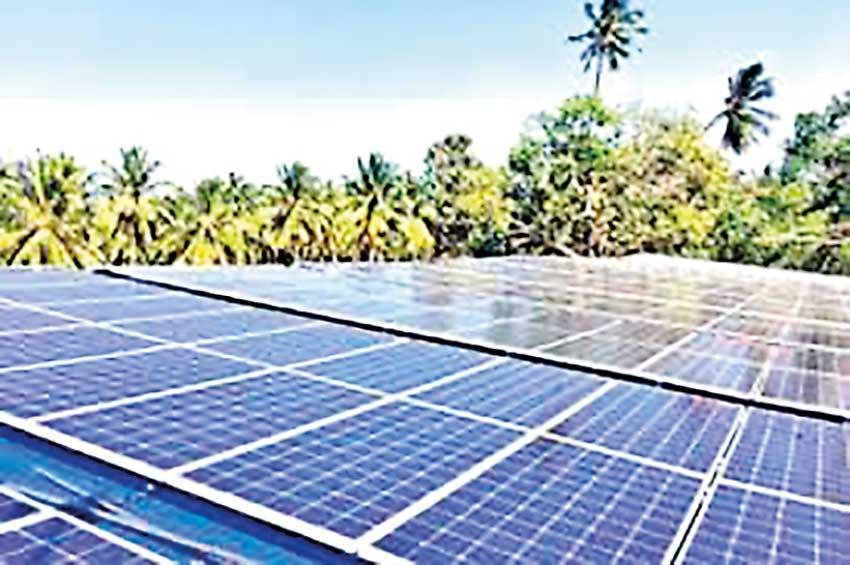07 May 2021 - {{hitsCtrl.values.hits}}

The Solar Industries Association of Sri Lanka (SIASL) is charging that the Ceylon Electricity Board (CEB) is attempting to cut solar power generation of new rooftop solar power projects on commercial establishments by as much as 50 percent while the country’s solar industry is struggling to survive through a crisis period due to the sharp depreciation of the rupee against the US dollar.
In a letter addressed to Minister of Power Dullas Alahapperuma and State Minister of Solar Power, Wind and Hydro Power Generation Projects Development Duminda Dissanayake, dated May 3, SIASL revealed that CEB recently modified how the capacity of new rooftop solar power system is determined.
According to the letter, signed by SIASL President Kushan Jayasuriya and SIASL General Secretary Lakmal Fernando, from 2016 to until March, the CEB considered the contract capacity of the customer to approve solar power projects on the roofs of manufacturing plants and commercial establishments
(contract demand).
However, the SIASL noted that this basis was modified by the CEB issuing a unilateral circular dated April 8, this year.
Accordingly, the capacity of the proposed solar power system to be built on roofs now will be determined by the maximum number of kVA units consumed in the last six months.
However, the Association questioned as to how the capacity of a rooftop solar power project, which is planned for 20 years, could be determined based on short-term electricity consumption patterns.
“As the world was battling with the pandemic, many factories, hotels as well as offices in the country were also operating at less than half of their capacity in the whole of last year. Declining global demand for the garment industry in particular, non-attendance of tourists and restrictions on office visits under quarantine laws have reduced electricity bills in Sri Lanka’s industries, hotels and offices approximately to around 50 percent,” the letter read.
It further stressed that when determining the capacity of new solar projects, the future demand must be factored in, given the long-term nature of the power plants.
Summing up, the SIASL claimed that the country could see a 50 percent drop in annual new solar power generation, which is being currently added to the national grid at around 60MW per annum.
While stating that the SIASL membership is puzzled by the latest move of CEB, the Association viewed this move is initiated by a few CEB officials to cripple the solar power industry in the country, to push the country towards purchasing more from thermal sources.
With 400 MW installed capacity (including power systems under construction) as of December last year, the SIASL highlighted that it supplies 525 million electricity units at Rs.19.80 per unit to the national grid and thereby saving a record Rs.5.4 billion for CEB per annum instead of having to purchase diesel or furnace oil-based electricity at Rs.30 per unit.
The Association estimated that rooftop solar sector contributes cost savings of around Rs.15 million to the CEB on a daily basis, which is on an increasing trend due to the rupee depreciation.
In particular, the Association pointed out that it was able to supply 1.6 million KWH of electricity to the national grid during the recent drought period (January to April), which avoided the CEB having to purchase power from the private sector at higher prices.
According to the letter, the country’s solar industry is currently going through a crisis period due to the considerable depreciation of the rupee against the US dollar, while the unit price of solar power remains unchanged for next 20 years.
“When the unit price of rooftop solar was decided at Rs. 19.80 in 2016 for the next 20 years, the exchange rate of US$ was at Rs.150. However, exchange rate of US$ has now exceeded Rs. 200 while the unit price of rooftop solar remains the same,” it noted.
As 80 percent of investment in a solar system needs to be paid in US$, the industry has been operating under severe difficulties. In addition, the suspension of forex forward contracts has also eradicated the industry’s ability to protect itself from potential foreign exchange losses.
In conclusion, SIASL urged the direct intervention of the government to halt the alleged move by the CEB to cripple solar power generation in the country.
Moving forward, the Association views that a fundamental change is required in CEB engineers’ mindset concerning thermal power projects, in order to realise the full potential of solar power generation, instead of continuing to rely on power generation with imported thermal sources.
The letter was also copied to the Presidential Secretariat and other key State officials. (NF)
19 Nov 2024 15 minute ago
19 Nov 2024 1 hours ago
19 Nov 2024 1 hours ago
19 Nov 2024 2 hours ago
19 Nov 2024 3 hours ago